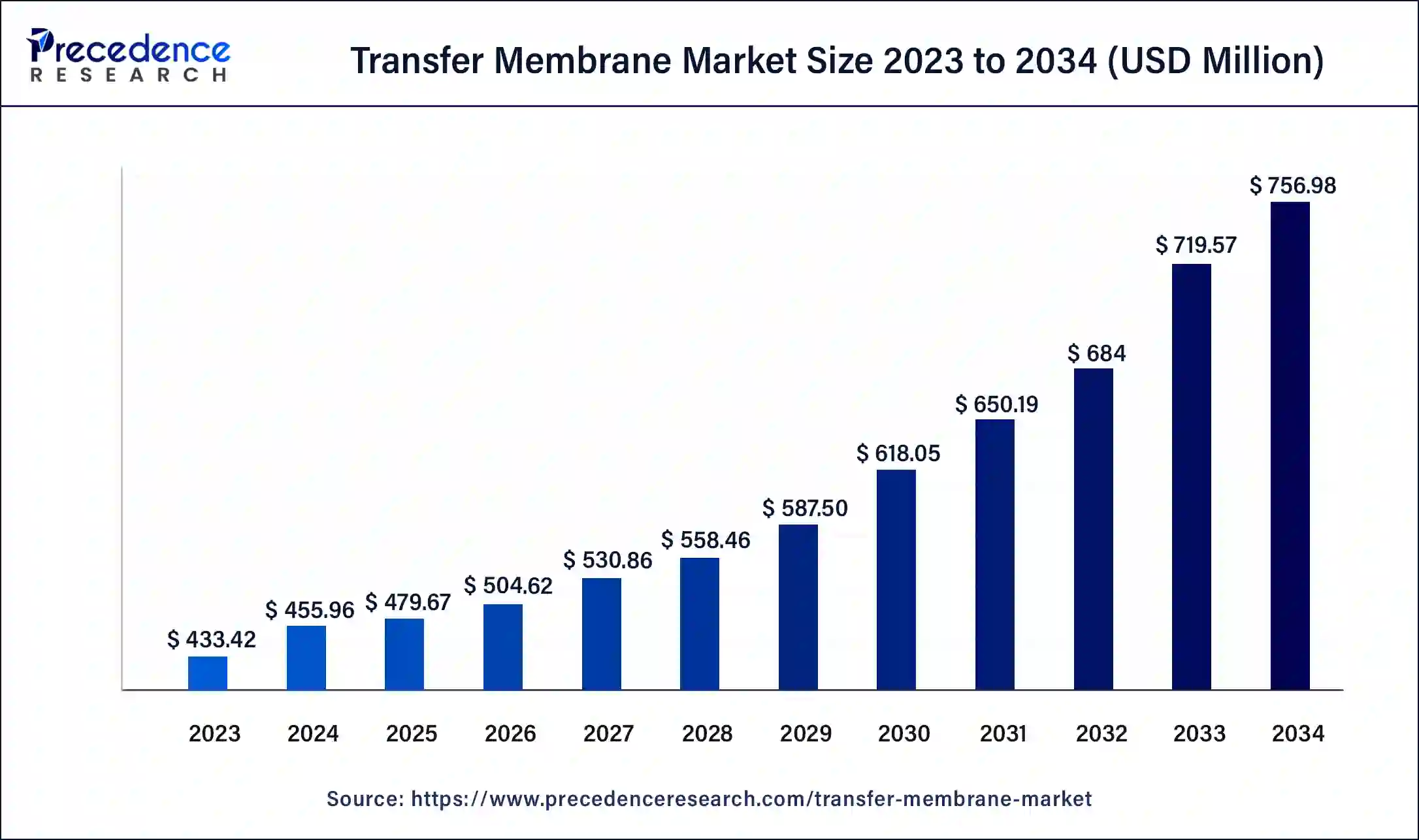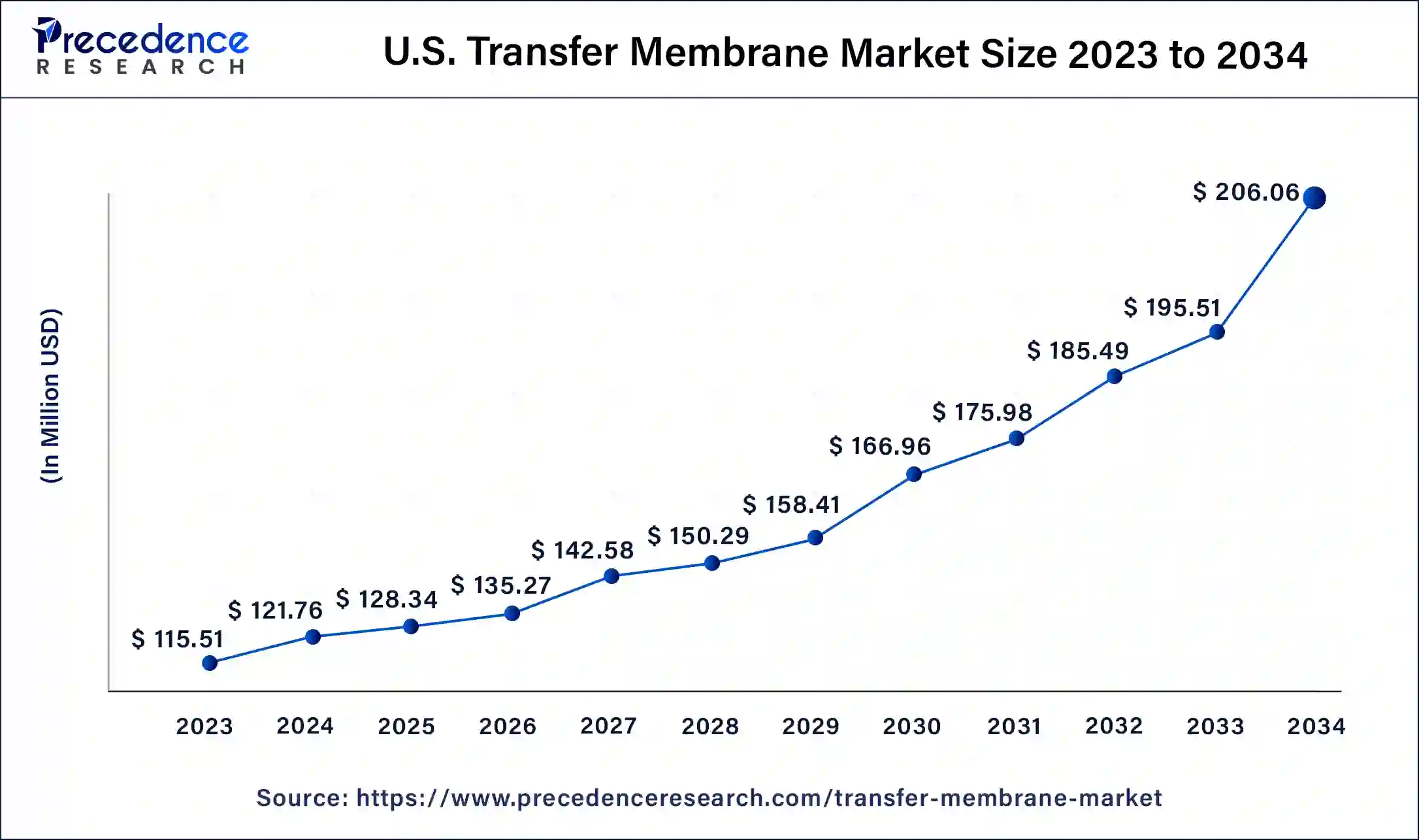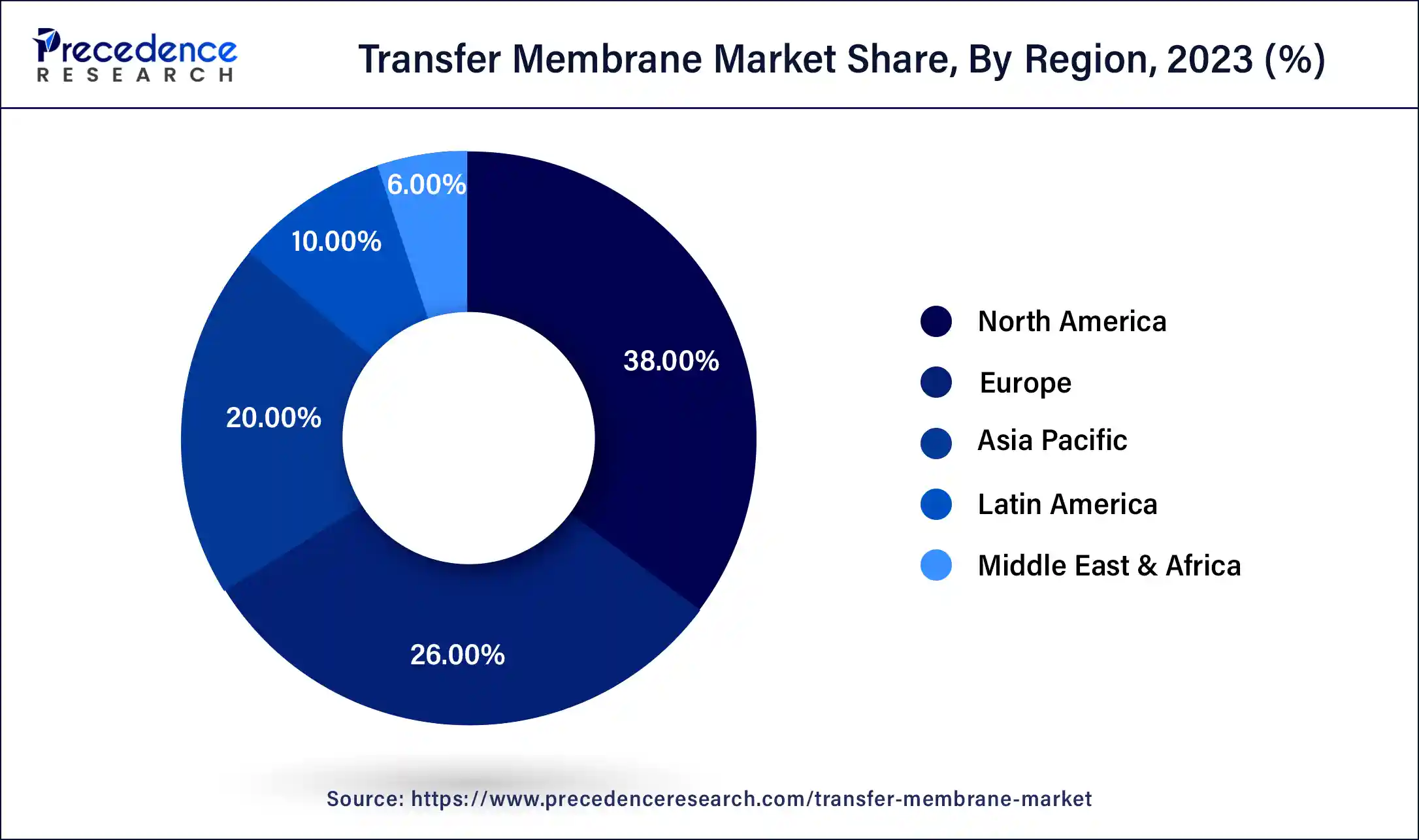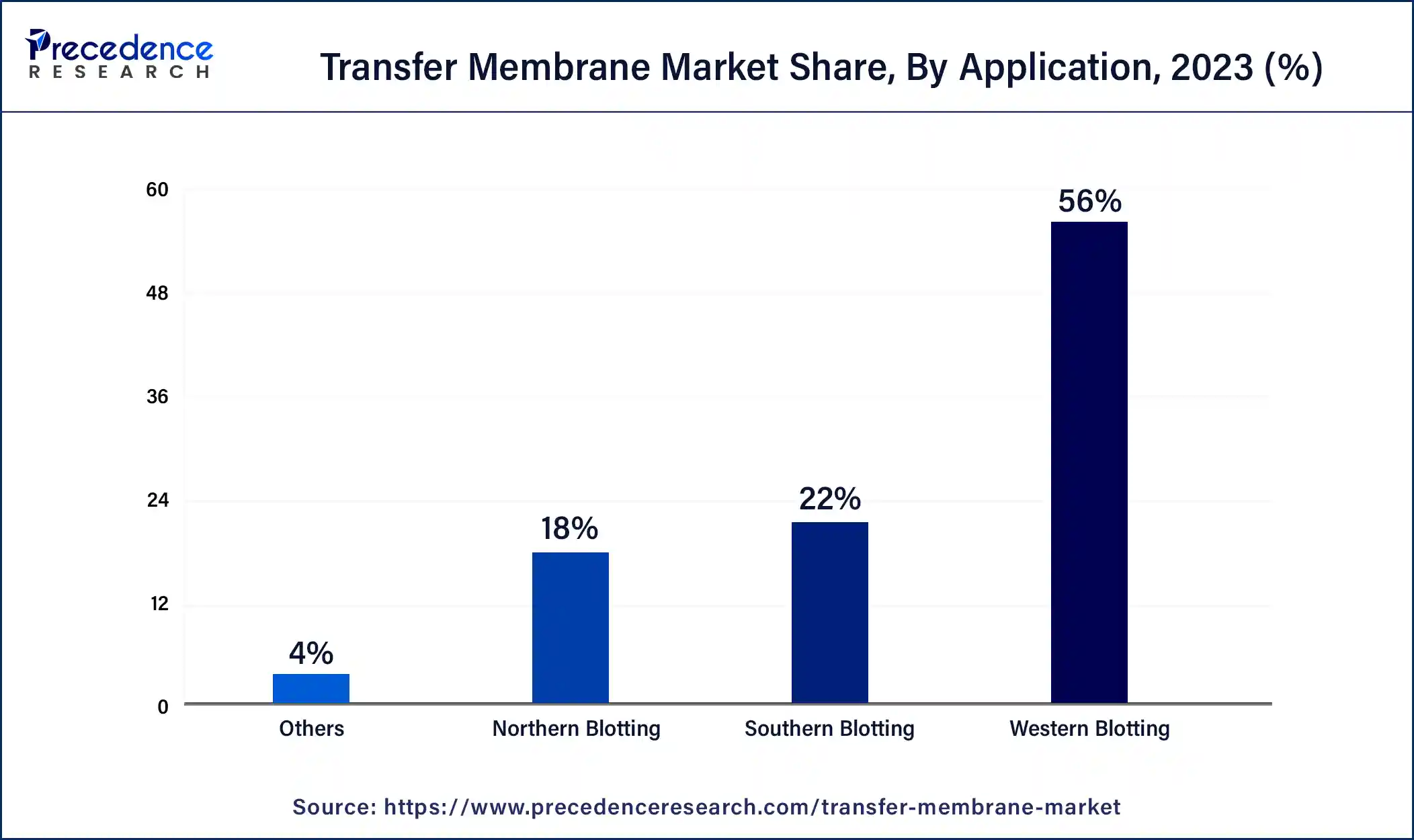List of Contents
Transfer Membrane MarketSize and Companies
The global transfer membrane market size was USD 433.42 million in 2023, accounted for USD 455.96 million in 2024, and is expected to reach around USD 756.98 million by 2034, expanding at a CAGR of 5.2% from 2024 to 2034.The North America transfer membrane market size reached USD 164.70 million in 2023.

Transfer Membrane Market Key Takeaways
- North America has generated more than 38% of revenue share in 2023.
- Asia Pacific is predicted to grow at the quickest CAGR of 5.94% between 2024 and 2034.
- By Product, the PVDF segment captured more than 40% of revenue share in 2023.
- By Application, western blotting has recorded the highest revenue share in 2023.
- By End-User, the pharmaceutical and biopharmaceutical companies are predicted to generate the maximum market share between 2024 and 2034.
U.S. Transfer Membrane Market Size and Growth 2024 to 2034
The U.S. transfer membrane market size was estimated at USD 115.51 million in 2023 and is predicted to be worth around USD 206.06 million by 2034, at a CAGR of 5.4% from 2024 to 2034.

North America dominates the transfer membrane market across the world. North America is the home ground for multiple universities and research institutes, with the increase in government funding for research and development, demand for personalized medicine, and expanding research in genomics and proteomics, particularly for chronic diseases such as diabetes, hypertension, etc., driving the transfer membrane market to grow. The region has a high prevalence of lifestyle-related diseases such as obesity, which further causes the demand for medications. Furthermore, North America is home to many major pharmaceutical companies, which has led to a significant investment in the research and development of new drugs.

This has resulted in the availability of a wide range of medications, including innovative treatments for complex diseases. The COVID-19 pandemic has also increased the demand for pharmaceuticals in North America, particularly for vaccines and treatments for the virus. North America's high drug demand will continue in the coming years.
The Asia Pacific region has a large and rapidly growing population, which creates a large market for goods and services. With a population of over 4.5 billion, the area has a significant consumer base driving economic growth. Many countries in the Asia Pacific region have undertaken economic reforms to promote growth and development. These reforms have included deregulation, privatization, and liberalization of trade and investment, which have helped to attract foreign investment and spur economic growth.
Market Overview
The transfer membrane market refers to the global market for various transfer membranes used in multiple applications, such as Western blotting, protein sequencing, and nucleic acid transfer. Transfer membranes are thin, porous sheets made of various materials such as nitrocellulose, polyvinylidene difluoride (PVDF), and nylon. They transfer proteins or nucleic acids from a gel or a blotting paper to solid support for analysis or detection.
The transfer membrane market includes products such as nitrocellulose membranes, PVDF membranes, nylon membranes, and other specialized membranes, as well as related accessories and consumables such as transfer buffers, filter papers, and pre-cut membranes. The increasing demand for transfer membranes in research and diagnostics applications and the growing use of transfer membranes in industries such as pharmaceuticals, biotechnology, and food testing drive the market.
Transfer Membrane Market Growth Factors
The transfer membrane market is expected to grow due to the increasing demand for protein analysis in various fields, such as medical research, biotechnology, and pharmaceuticals. The development of new transfer membrane technologies, such as improved pore size, better binding capacity, and increased sensitivity, is expected to boost the growth of the transfer membrane market. The increasing use of western blotting for protein analysis and the rising demand for this technique in the biotechnology and pharmaceutical industries are expected to drive the growth of the transfer membrane market.
The growing research and development activities in genomics, proteomics, and drug discovery are expected to drive the demand for transfer membranes. The ever-increasing demand for diagnostic testing in the healthcare industry, including protein-based diagnostic tests, is expected to drive the growth of the transfer membrane market. The increasing investments in biotechnology and pharmaceutical industries across the globe are expected to create significant opportunities for the transfer membrane market.
The increasing prevalence of chronic diseases such as cancer, diabetes, and cardiovascular diseases is expected to drive the demand for transfer membranes in medical research. The growing trend toward personalized medicine and the increasing use of protein-based biomarkers for disease diagnosis and treatment are expected to drive the growth of the transfer membrane market. The rising demand for point-of-care testing and the development of portable diagnostic devices are expected to drive the growth of the transfer membrane market. The increasing adoption of transfer membranes in academic and research institutes for protein analysis is expected to fuel the development of the transfer membrane market.
Market Scope
| Report Coverage | Details |
| Market Size in 2023 | USD 433.42 Million |
| Market Size in 2024 | USD 455.96 Million |
| Market Size by 2034 | USD 756.98 Million |
| Growth Rate from 2024 to 2034 | CAGR of 5.2% |
| Largest Market | North America |
| Base Year | 2023 |
| Forecast Period | 2024 to 2034 |
| Segments Covered | By Product, By Transfer Method, By Application, By End-User |
| Regions Covered | North America, Europe, Asia-Pacific, Latin America, and Middle East & Africa |
Market Dynamics
Market Drivers:
- Growing demand in various industries - Transfer membranes have applications in various industries, such as biotechnology, pharmaceuticals, healthcare, and food and beverage. The increasing demand in these industries is driving the growth of the transfer membrane market.
- Increasing research and development activities - Research and development activities in the biotechnology and pharmaceutical industries are driving the growth of the transfer membrane market. Transfer membranes are widely used in laboratory experiments, drug discovery, and protein analysis. According to the World Health Organization (WHO), the urgency for COVID-19 vaccines, scientific collaborations, and unprecedented financial investments are changing how vaccines are formed. For instance, some clinical trials evaluate multiple vaccines simultaneously, making the studies more rigorous.
- Technological advancements - Advancements in technology have led to the development of more efficient and reliable transfer membranes, which are driving the market's growth. New materials, improved designs, and manufacturing processes have also contributed to the development of the market.
- Government initiatives - Government initiatives to promote research and development activities in the biotechnology and pharmaceutical industries are driving the growth of the transfer membrane market. Funding for research and development activities and establishing research centers are examples of government initiatives that have contributed to the market's growth.
Market Restraints:
- Environmental concerns - Transfer membranes are typically made of synthetic materials that may not be biodegradable, which could lead to environmental concerns if not disposed of properly.
- Cost - Transfer membranes can be costly, especially for large-scale applications, which may limit the use of transfer membranes for some research projects or industries with limited budgets.
- Quality issues - Transfer membranes can be delicate and require specific handling and storage conditions to maintain quality. Handling during transport or storage could affect their performance and lead to accurate experiment results.
Market Opportunities:
- Growing demand for diagnostic testing - Transfer membranes are used in diagnostic testing for various diseases, including cancer, infectious diseases, and genetic disorders. As the demand for diagnostic testing continues to grow, the transfer membrane market is expected to expand.
- Increasing research and development activities -With the increasing focus on drug discovery and development, there is a growing demand for transfer membranes in research laboratories. This is expected to drive growth in the transfer membrane market in the coming years.
- Emerging markets - Due to the increasing demand for healthcare products and services, the transfer membrane market is expanding in emerging markets such as Asia-Pacific, Latin America, and the Middle East. These regions offer significant growth opportunities for transfer membrane manufacturers and suppliers.
Impact of COVID-19:
The COVID-19 pandemic has had a significant impact on the transfer membrane market. Transfer membranes are widely used in various applications, including western blotting, nucleic acid transfer, and protein sequencing. The demand for transfer membranes has been affected by the pandemic disrupting global supply chains and the shutdown of many industries. One of the significant impacts of the pandemic on the transfer membrane market has been supply chain disruption. The manufacturing of transfer membranes requires raw materials and chemicals, and with the pandemic causing widespread disruptions in transportation and logistics, the supply of these materials has been affected. This has led to a shortage of transfer membranes, resulting in higher prices and longer lead times for delivery.
The pandemic has also affected the demand for transfer membranes. Many research institutions and universities have been closed or operating at reduced capacity, leading to a slowdown in research activities that require transfer membranes. Furthermore, the economic impact of the pandemic has led to budget cuts in some industries, leading to a decrease in demand for transfer membranes. However, the pandemic has also created new opportunities for the transfer membrane market. With the focus on developing vaccines and treatments for COVID-19, there has been a surge in demand for transfer membranes for use in research and development. The use of transfer membranes in diagnostic testing for COVID-19 has also increased demand.
Product Insights
PVDF (polyvinylidene fluoride) is a type of polymer commonly used in the production of transfer membranes for transferring proteins and nucleic acids during Western blotting and other similar techniques. One of the critical reasons why PVDF is leading the transfer membrane market is its superior properties compared to different types of membranes. PVDF membranes offer high binding capacity, excellent protein retention, and low background noise, making them ideal for various applications in molecular biology and biotechnology research. Additionally, PVDF membranes are highly durable and resistant to chemicals and solvents, which means they can be used multiple times without compromising performance. They are also compatible with various detection methods, including chemiluminescence and fluorescent detection.
Nitrocellulose membranes have been widely used in protein blotting applications for many years and are well-suited for various detection methods. However, they can be brittle and tend to shrink during transfer, resulting in distortion of the protein bands.
Transfer Method Insights
The dry electro blotting segment holds the maximum share of the market. It is a technique used to isolate proteins on a micro-level. It also helps efficiently transfer the substance with a more incredible speed. The transfer speed is faster in dry electro-blotting than in wet transfer, as there is no need to equilibrate the buffer and the transfer membrane. The transfer is also more consistent, as the electric field is applied directly to the gel matrix, resulting in uniform transfer across the entire gel. Furthermore, dry electro-blotting does not require buffer solutions, which can be expensive and require special disposal procedures. This makes dry electro-blotting a more cost-effective and environmentally friendly option.
Application Insights
Western Blotting has accounted for the largest share of the market revenue. Transfer membrane, as it serves two purposes, i.e., its ease to access the target protein and the other is a good handling facility.

End-User Insights
Pharmaceutical and Biopharmaceutical Companies have the largest market globally. Increases in infrastructure, globalization, research funding by public and private bodies, and technological advancements such as next-generation sequencing, protein sequencing, and RNA sequencing are enhancing market growth. The pharmaceutical and biopharmaceutical industries heavily invest in research and development to develop new drugs and therapies, which require a lot of experimentation and analysis. As a result, these industries have a high demand for transfer membranes, making them one of the largest markets for these products.
Recent Developments:
- In March 2023, an innovative cell therapy initiative will be the focus of a new strategic relationship between the University of Pennsylvania and Danaher Corporation. The multi-year partnership aims to create new technologies, reduce production bottlenecks, and provide next generation engineered cell products to patients with consistent clinical outcomes.
- In January 2023, the chemiSOLO, a high-performance, a portable chemiluminescent imaging device that is small and reasonably priced, has been released by Azure Biosystems Inc. A dedicated computer is unnecessary because the chemiSOLO may be operated using a state-of-the-art web-based interface on a smartphone, tablet, or laptop.
Transfer Membrane Market Companies:
- Bio-Rad Laboratories
- Merck KGaA
- Santa Cruz Biotechnology, Inc.
- ATTO Corporation
- Thermo Fisher Scientific, Inc.
- Danaher
- Azure Bio systems Inc.
- Advansta Inc.
- GVS S.p.A.
- PerkinElmer, Inc.
- Abcam Plc.
Segments Covered in the Report:
By Product
- Nitrocellulose
- PVDF
- Nylon
By Transfer Method
- Wet or Tank Transfer
- Semi-dry Electro Blotting
- Dry Electro Blotting
- Others
By Application
- Northern Blotting
- Southern Blotting
- Western Blotting
- Others
By End-User
- Academic & Research Institutes
- Pharmaceutical & Biopharmaceutical Companies
- Diagnostic Labs
By Geography
- North America
- Europe
- Asia-Pacific
- Latin America
- Middle East and Africa
For inquiries regarding discounts, bulk purchases, or customization requests, please contact us at sales@precedenceresearch.com
Frequently Asked Questions
Ask For Sample
No cookie-cutter, only authentic analysis – take the 1st step to become a Precedence Research client